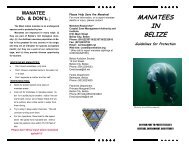The Placencia Lagoon - Coastal Zone Management Authority and ...
The Placencia Lagoon - Coastal Zone Management Authority and ...
The Placencia Lagoon - Coastal Zone Management Authority and ...
Create successful ePaper yourself
Turn your PDF publications into a flip-book with our unique Google optimized e-Paper software.
inundation during the rain season. <strong>The</strong> principal waterway, Big Creek, is fed by<br />
numerous small streams <strong>and</strong> debouches at the southernmost end of the <strong>Placencia</strong> <strong>Lagoon</strong>.<br />
<strong>The</strong> vegetation cover within this catchment includes marshl<strong>and</strong>s, mangroves, grass<br />
meadows <strong>and</strong> pine ridge.<br />
It is worth pointing out that none of the watercourses that flow into the <strong>Placencia</strong> <strong>Lagoon</strong><br />
are gauged, hence there are no time series on the discharge <strong>and</strong> water levels (Hydrology<br />
Service, 2003). However, Grimshaw (2000) purports that the combined low flow for<br />
August <strong>and</strong> Mango Creeks is 0.7 CMS. Furthermore the low flow for Jenkins <strong>and</strong> Flour<br />
Camp Creeks was estimated at 0.8 CMS. Silver Creek was estimated to have a low flow<br />
of 1.3 CMS.<br />
<strong>The</strong> ground water resources map of Belize divides the country into ten regions based on<br />
water availability <strong>and</strong> quality (Buckalew et al., 1998). <strong>The</strong> terrestrial zone of influence on<br />
the <strong>Placencia</strong> <strong>Lagoon</strong> falls into two of these regions.<br />
(1) <strong>The</strong> <strong>Placencia</strong> Peninsula <strong>and</strong> the western margin of the lagoon are classified as areas<br />
where small to large quantities of brackish to saline water are available. Also, meager to<br />
very small quantities of fresh water are available from quaternary alluvium <strong>and</strong> coastal<br />
deposits along the coast. Depth to water is 2 to 50 meters.<br />
(2) <strong>The</strong> wider extent of the terrestrial zone of influence is that part of the Central <strong>Coastal</strong><br />
Plain composed of s<strong>and</strong>y shales, shales, claystones, mudstones, <strong>and</strong> alluvium. <strong>The</strong>se<br />
deposits bear meager to moderated quantities of freshwater. Depth to water is generally<br />
less than 60 meters.<br />
Although, there is limited information about the ground water distribution in the<br />
terrestrial zone influencing the lagoon, it is envisaged that ground water might have some<br />
effects on the water budget of the <strong>Placencia</strong> <strong>Lagoon</strong>.<br />
Meteorology<br />
<strong>The</strong> <strong>Placencia</strong> <strong>Lagoon</strong> <strong>and</strong> adjacent catchments fall in a tropical climatic zone. Walker<br />
(1973), King et al. (1989, 1992) documented the rainfall distribution for Belize <strong>and</strong><br />
indicate that the annual rainfall for the <strong>Placencia</strong> area varies between 80 inches (2032<br />
mm) <strong>and</strong> 100 inches (3048 mm). <strong>The</strong> mean annual temperature for the region is 28°C <strong>and</strong><br />
the mean relative humidity is 80%. <strong>The</strong> predominant winds are out of the Southeast at a<br />
mean speed of 4 knots.<br />
<strong>The</strong> Belize National Meteorological Service (BNMS) has a countrywide network of<br />
climatological stations. Station 28 located at Rum Point Inn <strong>and</strong> station 29 located at the<br />
Savannah Forest Station are the stations nearest to the <strong>Placencia</strong> <strong>Lagoon</strong>.<br />
9



